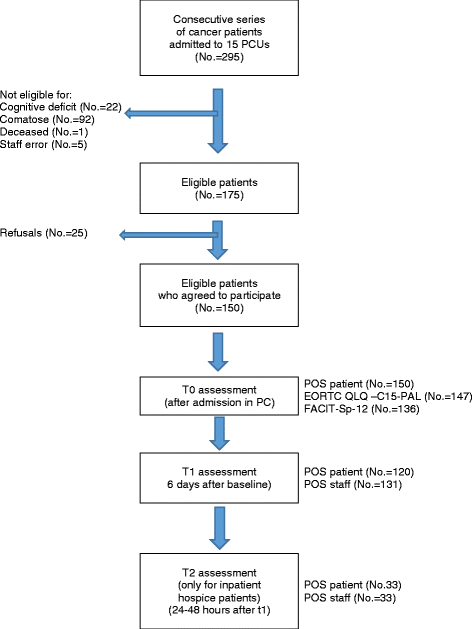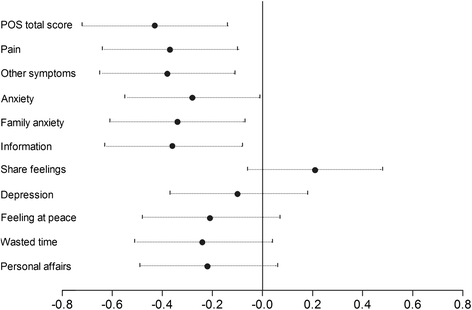Validity, reliability and responsiveness to change of the Italian palliative care outcome scale: a multicenter study of advanced cancer patients
- PMID: 26920738
- PMCID: PMC4768331
- DOI: 10.1186/s12904-016-0095-6
Validity, reliability and responsiveness to change of the Italian palliative care outcome scale: a multicenter study of advanced cancer patients
Abstract
Background: There is an increasing requirement to assess outcomes, but few measures have been tested for advanced medical illness. We aimed to test the validity, reliability and responsiveness of the Palliative care Outcome Scale (POS), and to analyse predictors of change after the transition to palliative care.
Methods: Phase 1: multicentre, mixed method study comprising cognitive and qualitative interviews with patients and staff, cultural refinement and adaption. Phase 2: consecutive cancer patients on admission to 8 inpatient hospices and 7 home-based teams were asked to complete the POS, the EORTC QLQ-C15-PAL and the FACIT-Sp (T0), to assess internal consistency, convergent and divergent validity. After 6 days (T1) patients and staff completed the POS to assess responsiveness to change (T1-T0), and agreement between self-assessed POS and POS completed by the staff. Finally, we asked hospices an assessment 24-48 h after T1 to assess its reliability (test re-test analysis).
Results: Phase I: 209 completed POS questionnaires and 29 cognitive interviews were assessed, revisions made and one item substituted. Phase II: 295 consecutive patients admitted to 15 PCTs were approached, 175 (59.3 %) were eligible, and 150 (85.7 %) consented. Consent was limited by the severity of illness in 40 % patients. We found good convergent validity, with strong and moderate correlations (r ranged 0.5-0.8) between similar items from the POS, the QLQ-C15-PAL and the FACIT-Sp. As hypothesised, the physical function subscale of QLQ-C15-PAL was not correlated with any POS item (r ranged -0.16-0.02). We found acceptable to good test re-test reliability in both versions for 6 items. We found significant clinical improvements during the first week of palliative care in 7/10 items assessed-pain, other symptoms, patient and family anxiety, information, feeling at peace and wasted time.
Conclusions: Both the patient self-assessed and professional POS versions are valid and with an acceptable internal consistency. POS detected significant clinical improvements during palliative care, at a time when patients are usually expected to deteriorate. These results suggest that there is room for substantial improvement in the management of patients with advanced disease, across all key domains-symptoms, psychological, information, social and spiritual.
Figures
References
Publication types
MeSH terms
Grants and funding
LinkOut - more resources
Full Text Sources
Other Literature Sources
Medical
Research Materials



